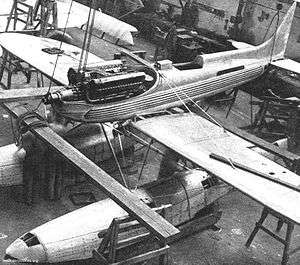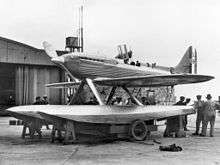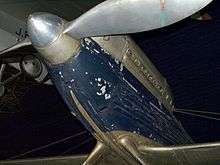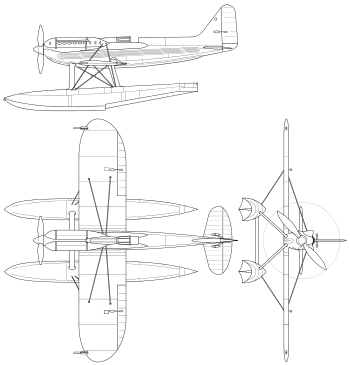Supermarine S.6B
| S.6B | |
|---|---|
 | |
| A Supermarine S.6B under construction, showing the Rolls-Royce R engine | |
| Role | Experimental aircraft, Racing seaplane |
| Manufacturer | Supermarine |
| Designer | R.J. Mitchell |
| First flight | 1931 |
| Introduction | 1931 |
| Primary user | Royal Air Force |
| Number built | 2 |
| Developed from | Supermarine S.6 |
The Supermarine S.6B is a British racing seaplane developed by R.J. Mitchell for the Supermarine company to take part in the Schneider Trophy competition of 1931. The S.6B marked the culmination of Mitchell's quest to "perfect the design of the racing seaplane" and represented the cutting edge of aerodynamic technology.
The last in the line developed by Supermarine, it followed the S.4, S.5 and the S.6.[1] Mitchell and his team's experience in designing high speed Schneider Trophy floatplanes greatly contributing to the development of the later Supermarine Spitfire, an iconic fighter and Britain's most successful interceptor of World War II.[2]
Funding
Despite Prime Minister James Ramsay MacDonald's pledge of government support for the next British race entrant immediately after the 1929 victory, official funding was withdrawn less than two months later following the Wall Street Crash, with the official reason given that the previous two contests had collected sufficient data on high speed flight, so further expenditure of public money was unwarranted.[3] A committee formed by the Royal Aero Club, who were responsible for organising the 1931 race, which included representatives from the aircraft and aero engine industries, was formed to discuss the feasibility of a privately funded entry but concluded that not only would this be beyond their financial reach but that the lack of the highly skilled RAF pilots of the High-Speed Flight would pose a severe problem. This caused enormous public disappointment: having won two successive races a victory in a third race would secure the trophy outright.
As ever active in aviation affairs, Lord Rothermere's Daily Mail group of newspapers launched a public appeal for money and several thousand pounds were raised, and after Lady Houston publicly pledged £100,000 the Government changed its position and announced its support for an entry in January 1931, leaving less than nine months to prepare any race entrant. The RAF High Speed Flight was reformed, and Mitchell and Rolls-Royce set to work.[4]
Design and development
There were only seven months to prepare an entry, and as Mitchell did not have enough time to design a new aircraft improved performance had to be obtained by getting more power from the R-Type engine[5] Modifications to the airframe design were limited to minor improvements and some strengthening in order to cope with the increased weight of the aircraft. Additionally, the floats were extended forward by some three feet (0.9 m). Rolls-Royce had managed to increase the power of the engine by 400 hp (298 kW) to 2,300 hp (1,715 kW).
Operational history

Although the British team faced no competitors, the RAF High Speed Flight brought six Supermarine Schneider racers to Calshot Spit on Southampton Water for training and practice. The aircraft were: S.5 N219, second at Venice in 1927, S.5 N220, winner at Venice in 1927, two S.6s with new engines and redesignated as S.6As (N247 that won at Calshot in 1929 and S.6A N248, disqualified at Calshot in 1929), and the newly built S.6Bs, S1595 and S1596.[6]
The improved aircraft was designated the Supermarine S.6B to differentiate the variant from the S.6A. The British plan for the Schneider contest was to have S1595 fly the course alone and if its speed was not high enough, or it encountered mechanical failure, then the more proven S.6A N248 would fly the course. If both S1595 and N248 failed in their attempts, N247 held in reserve would be used. The S.6B S1596 was then to attempt the World Air Speed Record. During practice, N247 was destroyed in a takeoff accident, resulting in the death of the pilot, Lieut. G. L. Brinton, R.N.,[7] precluding any other plans with only the two S.6Bs and the surviving S.6 prepared for the final Schneider run.[6]
The winning Schneider flight was piloted by Flt. Lt. John Boothman in aircraft serial number S1595 at a speed of 340.08 mph (547.19 km/h), flying seven perfect laps of the triangular course over the Solent, between the Isle of Wight and the British mainland. Seventeen days later, Flt Lt. George Stainforth in S.6B serial S1596 broke the world air speed record reaching 407.5 mph (655.67 km/h).[8]


The S.6B is hailed as giving the impetus to the development of the Supermarine Spitfire and the Rolls-Royce Merlin engine.[4]
Aircraft on display
At the completion of the record flights, both S.6Bs were retired. The Schneider Trophy winning S.6B S1595 was donated to the Science Museum in London, where it resides in an unrestored state.[4] For a short period of time, S1596 was tested at the Marine Aircraft Experimental Establishment (MAEE) at Felixstowe.[6] Until the 1960s, S.6A N248 was displayed incorrectly as S1596 at Southampton Royal Pier as a visitor attraction.[9] The ultimate fate of the S1596 is unknown.
Operators
Specifications (S.6B)
Data from Supermarine Aircraft since 1914[10]
General characteristics
- Crew: 1
- Length: 28 ft 10 in (8.79 m)
- Wingspan: 30 ft 0 in (9.14 m)
- Height: 12 ft 3 in (3.73 m)
- Wing area: 145 ft² (13.5 m²)
- Empty weight: 4,590 lb (2,082 kg)
- Loaded weight: 6,086 lb (2,760 kg)
- Max. takeoff weight: lb (kg)
- Powerplant: 1 × Rolls-Royce R, 2,350 hp (1,753 kW)
Performance
- Maximum speed: 354 kn (407.5 mph, 655.8 km/h) (world speed record)
- Wing loading: 42 lb/ft² (205 kg/m²)
- Power/mass: 0.386 hp/lb (0.635 kW/kg)
See also
- Related development
- Aircraft of comparable role, configuration and era
References
Notes
- ↑ Price 1977, p. 11.
- ↑ Nichols 1996, p. 9.
- ↑ Andrews and Morgan 1987, pp. 194–195.
- 1 2 3 Winchester 2005, p. 238.
- ↑ Green 1967, pp. 745–746.
- 1 2 3 Green 1967, p. 744.
- ↑ "Death of Lt. Brinton." Flight, 21 August 1931.
- ↑ Price 1977, p. 12.
- ↑ "Royal Pier, Southampton, Hampshire." The Heritage Trail, 1998-2008. Retrieved: 17 September 2009.
- ↑ Andrews and Morgan 1987, p. 203
Bibliography
- Andrews, C.F. and E.B. Morgan. Supermarine Aircraft since 1914, 2nd edition. London: Putnam, 1987. ISBN 0-85177-800-3.
- Green, William, ed. "Supermarine's Schneider Seaplanes." Flying Review International, Volume 10, No. 11, July 1967.
- McKinstry, Leo. Spitfire – Portrait of a Legend. London: John Murray, 2007. ISBN 0-7195-6874-9.
- Nichols, Mark, ed. Spitfire 70: Invaluable Reference to Britain's Greatest Fighter, Flypast Special. Stamford, Linc, UK: Key Publishing, 1996.
- Price, Alfred. Spitfire: A Documentary History. New York: Charles Scribner's Sons, 1997. ISBN 0-684-16060-9.
- Robertson, Bruce. Spitfire: Story of a Famous Fighter. London: Harleyford, 1962. ISBN 0-900435-11-9.
- Shelton, John (2008). Schneider Trophy to Spitfire - The Design Career of R.J. Mitchell (Hardback). Sparkford: Hayes Publishing. ISBN 978-1-84425-530-6.
- Spick, Mike. Supermarine Spitfire. New York: Gallery Books, 1990. ISBN 0-8317-1403-4.
- Winchester, Jim. "Supermarine S.6B". Concept Aircraft: Prototypes, X-Planes and Experimental Aircraft. Kent, UK: Grange Books plc., 2005. ISBN 978-1-84013-809-2.
External links
| Wikimedia Commons has media related to Supermarine S.6B. |
- Air racing history
- RJ Mitchell: A life in aviation, 1931 Schneider Trophy, Cowes
- 16mm B&W Newsreel footage of 1931 Schneider Trophy
- "The Supermarine S.6b", Popular Mechanics, December 1931, complete detailed cutaway drawings of S.6B
- Photo walk around by Don Busack of the actual Schneider Trophy winning Supermarine S.6B displayed at the Science Museum, London.
- "The Supermarine S.6B Monoplane." Flight, 2 October 1931, pp. 981–982.